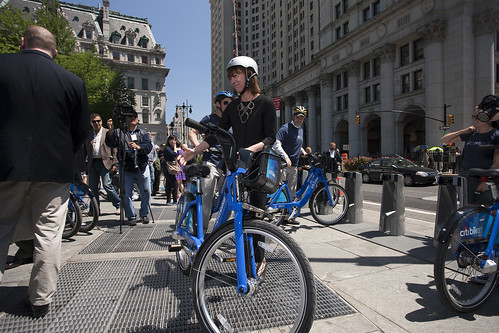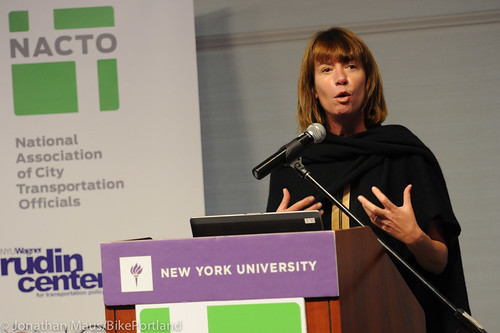Maybe the best next job for Janette Sadik-Khan would be to run a state level department of transportation
There is a lot of speculation on what two of Mayor Bloomberg's highest level appointees, Amanda Burden, the chief planner, and Janette Sadik-Khan, the transportation commissioner, will be doing after Mayor Bloomberg leaves office.
The scuttlebutt is that they will join together and start their own consulting outfit to offer their services to cities around the globe looking for innovative planning solutions.

Janette Sadik-Khan at the launch of bicycle sharing in NYC. NYC DOT Flickr photo.
Although for while I did think Janette Sadik-Khan, would have been great as the US Secretary of Transportation in the Obama Administration, in thinking about some of my responses to the proposed wackjob legislation the federal Transportation Empowerment Act proposed by Utah Senator Mike Lee (also see "Topic of the week: No more federal gas tax?," from GGW), I think this could be the most transformative step she could take for transportation policy and practice.
It is basically a load of s**t that the reason to get rid of the federal gasoline excise tax for the most part and to devolve authority for the surface transportation network to the states is to ensure "diversity and innovation."
It's to defund federal practice.
1. But in the GGW entry there is the sentiment expressed that generally state departments of transportation are potentially innovative but are held back by the national US DOT.
2. For the most part, I think that sentiment is misplaced. Some of the only reason states do anything innovative is because previous federal programs targeted monies to certain kinds of innovative transportation infrastructure.
Although it's true that the US DOT is not always at the forefront of change in practice, because the profession generally at the state and federal level is shaped by a rural road building and transportation agenda that has been developed in the US over the past 100 years, and those various special interests (construction companies, oil companies, automobile manufacturers, etc.) that like things the way they are.
Also see the past blog entry "Transportation "frankness","about how the director of the Mississippi Transportation Department, and a member of the AASHTO board of directors, Butch Brown, called Ray LaHood, the U.S. Secretary of Transportation, an a**hole. Brown later backtracked and said he meant Secretary LaHood was overfocused on urban issues.
3. In a practical sense, motor vehicle primacy amongst transportation agency workers is derived from the education system that produces the civil and traffic engineers that fill up most of an agency's jobs.
Even in a city like DC, most transportation employees--especially the civil engineers and others involved in infrastructure provision and construction--aren't comfortable pushing overtly "pro-urban" solutions because that isn't what they are taught.
4. But, while the US DOT might not always be pushing the most innovative policies and practices--although they are restricted in large part by the laws produced by Congress which govern how they do business--the reality is that the US DOT is funding a great deal of research and publications on transportation innovation, funding pilot programs, providing specific funding streams for innovation, etc.
Examples include the support of national, regional, and state transportation centers (I read publications produced by these centers all the time, including the Mineta Center, the Volpe Center, and state and regional transportation centers at institutions such as the University of California, the University of Minnesota, and Rutgers University) and various initiatives such as the Transit Cooperative Research Program or the Highway Cooperative Research Program or the Airports Cooperative Research Program, to the funding of transit opportunities in national parks.
For example, some of the best resources on walking and biking issues are published by the US DOT.
In short, far more "diversity and innovation" is generated as a result of the US DOT than would be generated by State DOTs operating independently.
5. Where the real disconnect in transportation policy is within state departments of transportation; between states and metropolitan areas; states and cities; and metropolitan areas and cities (suburbs vs. cities).
Although there are some progressive state transportation agencies, in particular Oregon, and bits and pieces of innovative practice in just about every state transportation agency, for the most part state transportation agencies are the biggest hindrance to innovation in state and local transportation practice.
... for example, did you know that it isn't federal policy to restrict inclusion of bike infrastructure within "federal highways"? , they leave that decision to the states. So I-70 in Colorado includes some innovative bike trails, but freeways in Maryland do not. Etc.
Why not get someone like Janette Sadik-Khan to shake things up at that level of change--the locus of a state department of transportation. As Secretary of the US DOT, the person is too high up to see and get involved with the real problems--although given her recent experience as a city transportation commissioner, she does know the issues (as does former State of Maryland Secretary of Transportation John Porcari, who is now the Deputy Secretary of the US DOT).
At the state level, it's very different.

Bike Portland Flickr photo.
What about Virginia?
I'd be a stretch, and probably isn't a good fit because it's a job that would last for only one term--four years--but Virginia under incoming Gov. Terry McAuliffe would be one place. But I will say that the State has so many longstanding issues that make improvement difficult--the political ideology in favor of privatization of transportation infrastructure, a rural dominated legislature, the state controls most of the road infrastructure in the state, and much of it should be devolved to the counties, etc.
On the other hand, they have the port in Norfolk, a reasonably forward thinking rail transportation planning and expansion program, and airports in the DC region (technically these are controlled by a regional authority, but they are both physically located in Virginia).
Plus, Gov.-elect McAuliffe has already made his choice. See "McAuliffe expected to name Layne as transportation secretary: Realty investor represents Hampton Roads on Commonwealth Transportation Board" from the Richmond Times-Dispatch.
Maybe Maryland would be a better bet?
As the election cycle moves forward, maybe transportation advocates in Maryland could advocate to all those campaigning for Governor for someone like Janette Sadik-Khan too, to become the Secretary of Transportation, and push Maryland to the next level in terms of transportation innovation.
Labels: change-innovation-transformation, federal policies and the city, organizational behavior, organizational development, provision of public services, transportation planning



6 Comments:
How about DC? Let's get someone with some real vision and experience with implementation on board? Having such a visionary would allow all of the visitors see how great things can be and take those practices back to their states, counties and cities.
Considering Sadik-Khan's money and long time connections to NYC's elite, I doubt she'd leave NYC unless it was to some place in Europe or Asia. She was very good for NYC but I can't really see her work or style transfer to the state level. Plus there's plenty more to do here and organizations in NYC that would continue to need her in their corners.
As long as DC has limited vision amongst elected officials--despite the mouthings--people who are really good aren't want to going to be the director of ddot.
e.g., the piece in GGW about the reconstruction of part of the SE-SW Freeway which discusses how the department says that the 90 cent dollars from federal highway money are too important, and justify not changing the roadway significantly, because of having to come up with local money as an alternative.
Let's just say that we don't have people here on the scale of the kinds of people who've made freeway demolition decisions in places like SF, Milwaukee, Portland, etc.
... the streetcar project notwithstanding.
2. wrt Christopher's point, yes, I don's see JDK moving to a comparative "backwater" to make a point. But I still stand by my point that state DOTs need some shaking up.
oh, anon1, I've made that argument for years and years and argued that is another reason to interpret "urbanism" culturally and touristically in the city as part of the history interpretation system.
Plus my recent and old posts on integrating heritage streetcars into a streetcar system for historical reasons, and as part of a system serving the National Mall.
Christopher -- JDK even as NY State DOT commissioner would be a step forward.
Consideration should be given to Janette Sadik-Khan as an MPO Transportation Chief for a major metropolitan area. Sadly, DC now has an opening and someone with the innovation DNA of Janette Sadik-Khan should be a worthy candidate.
Post a Comment
<< Home